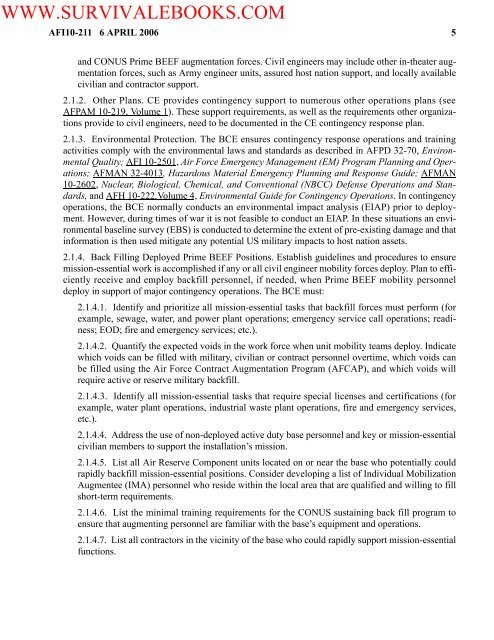2006 US Air Force CIVIL ENGINEER ... - Survival Books
2006 US Air Force CIVIL ENGINEER ... - Survival Books
2006 US Air Force CIVIL ENGINEER ... - Survival Books
- No tags were found...
Create successful ePaper yourself
Turn your PDF publications into a flip-book with our unique Google optimized e-Paper software.
WWW.SURVIVALEBOOKS.COMAFI10-211 6 APRIL <strong>2006</strong> 5and CON<strong>US</strong> Prime BEEF augmentation forces. Civil engineers may include other in-theater augmentationforces, such as Army engineer units, assured host nation support, and locally availablecivilian and contractor support.2.1.2. Other Plans. CE provides contingency support to numerous other operations plans (seeAFPAM 10-219, Volume 1). These support requirements, as well as the requirements other organizationsprovide to civil engineers, need to be documented in the CE contingency response plan.2.1.3. Environmental Protection. The BCE ensures contingency response operations and trainingactivities comply with the environmental laws and standards as described in AFPD 32-70, EnvironmentalQuality; AFI 10-2501, <strong>Air</strong> <strong>Force</strong> Emergency Management (EM) Program Planning and Operations;AFMAN 32-4013, Hazardous Material Emergency Planning and Response Guide; AFMAN10-2602, Nuclear, Biological, Chemical, and Conventional (NBCC) Defense Operations and Standards,and AFH 10-222,Volume 4, Environmental Guide for Contingency Operations. In contingencyoperations, the BCE normally conducts an environmental impact analysis (EIAP) prior to deployment.However, during times of war it is not feasible to conduct an EIAP. In these situations an environmentalbaseline survey (EBS) is conducted to determine the extent of pre-existing damage and thatinformation is then used mitigate any potential <strong>US</strong> military impacts to host nation assets.2.1.4. Back Filling Deployed Prime BEEF Positions. Establish guidelines and procedures to ensuremission-essential work is accomplished if any or all civil engineer mobility forces deploy. Plan to efficientlyreceive and employ backfill personnel, if needed, when Prime BEEF mobility personneldeploy in support of major contingency operations. The BCE must:2.1.4.1. Identify and prioritize all mission-essential tasks that backfill forces must perform (forexample, sewage, water, and power plant operations; emergency service call operations; readiness;EOD; fire and emergency services; etc.).2.1.4.2. Quantify the expected voids in the work force when unit mobility teams deploy. Indicatewhich voids can be filled with military, civilian or contract personnel overtime, which voids canbe filled using the <strong>Air</strong> <strong>Force</strong> Contract Augmentation Program (AFCAP), and which voids willrequire active or reserve military backfill.2.1.4.3. Identify all mission-essential tasks that require special licenses and certifications (forexample, water plant operations, industrial waste plant operations, fire and emergency services,etc.).2.1.4.4. Address the use of non-deployed active duty base personnel and key or mission-essentialcivilian members to support the installation’s mission.2.1.4.5. List all <strong>Air</strong> Reserve Component units located on or near the base who potentially couldrapidly backfill mission-essential positions. Consider developing a list of Individual MobilizationAugmentee (IMA) personnel who reside within the local area that are qualified and willing to fillshort-term requirements.2.1.4.6. List the minimal training requirements for the CON<strong>US</strong> sustaining back fill program toensure that augmenting personnel are familiar with the base’s equipment and operations.2.1.4.7. List all contractors in the vicinity of the base who could rapidly support mission-essentialfunctions.
















